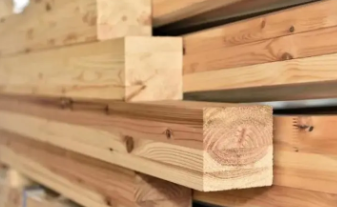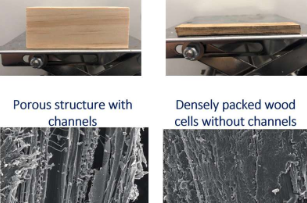Wood turns into "super material": it is suitable for automobile, aerospace, manufacturing engineering and other fields
Xianji.com/xing xiuyan/2022-04-11 15:23:08
With the development of reinforced concrete piles over the years, the use of wooden piles in civil infrastructure has decreased steadily. Although wooden piles are a renewable and low-cost foundation system, their low stiffness and strength limit their application in light load structures.
Hai "Thomas" Lin, an assistant professor in the Department of civil and environmental engineering at Louisiana State University, has developed wood with high stiffness and strength, which is durable and cost-effective and can be used in heavy-duty and elastic civil infrastructure called super wood.
Natural wood and super wood. Source: Louisiana State University School of Engineering
"* * * recent research on wood nanomaterials has led to a high-performance structural material called super wood," Lin said. "It is suitable for advanced applications in civil, automotive, aerospace and manufacturing engineering."
Superwood is a dense wood material produced by partially delignification of natural wood and subsequent densification by hot pressing. Super wood production is potentially sustainable and cost-effective because it avoids the energy intensive manufacturing processes associated with Portland cement and steel.
The strength and elastic modulus of super wood are not only better than natural wood, but also may exceed that of concrete. Superwood also has excellent durability and can resist decay and insects caused by moisture, such as termites, while the strength is reduced * * * little.
Super wood piles are expected to alleviate the shortcomings of current wood piles, such as low structural bearing capacity, easy damage and decay during hard driving, and exceed the performance of wood piles and concrete piles in service and strength limit states.
The aim of the research is to improve the termite resistance of the wood pile by optimizing its processing and processing conditions; The soil pile interaction behavior of super wood pile is studied by laboratory test; Develop numerical models to predict the response of super wood piles under different soil and load conditions; Evaluate the cost and environmental impact of super wood piles through life cycle analysis.

"This study will promote the further development of super wood in geotechnical engineering, including ground improvement, retaining wall and support of excavation structures," Lin said.
Lin's research will design and verify the super wood pile foundation system through the cooperation of geotechnical engineering and wood composite engineering researchers, using experimental and modeling technology and life cycle analysis. He will recruit two high school students from the Louisiana State University School of engineering high school summer research or HSSR program this summer.
"The HSSR program is an outreach program designed to involve high school students with outstanding performance in practical research in the field of engineering," Lin said. "As part of its strategic plan, mission and vision, the school of engineering is committed to cultivating students into the next generation of transformative problem solvers in the region, state and other regions."
This article is reproduced from https://www.hongyantu.com/news/29129.html , if there is infringement, please inform to delete






